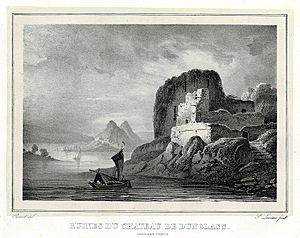Dunglass Castle facts for kids
Quick facts for kids Dunglass Castle |
|
|---|---|
| West Dunbartonshire | |
 |
|
| Coordinates | 55°55′45″N 4°30′10″W / 55.9291°N 4.5027°W |
| Site information | |
| Condition | Ruin |
| Site history | |
| Built | 1380 |
Dunglass Castle is an old castle ruin in West Dunbartonshire, Scotland. It sits on a rocky cliff right next to the River Clyde. This castle was built a long time ago, in the 14th century. Even though it's mostly ruins now, it's still an important historical building. In 1971, it was recognized as a special "Category B listed" building. There's also a tall stone monument, called an obelisk, on its land. This monument honors Henry Bell, who was a very important person in making early steamships.
History of Dunglass Castle
Dunglass Castle was built in 1380. It was the main home and center for the Colquhoun family and their land, known as the Barony of Colquhoun.
In February 1569, soldiers from Dumbarton Castle, led by Lord Fleming, attacked Dunglass Castle. However, the castle defenders fought them off. Lord Fleming's half-brother was even captured during this attack.
By the 1700s, the castle was already falling apart. In 1735, many stones from the castle and its courtyard were taken. These stones were used to repair the nearby quay (a landing place for boats). This continued until 1812, when Andrew Buchanan of Auchentorlie bought the castle. He stopped the practice of taking stones.
Later, in July 1893, a graphic artist named Talwin Morris leased the castle. He changed the inside of the house. In July 1899, the house was sold to the parents of his friends, Margaret and Frances Macdonald. After this, another famous artist, Charles Rennie Mackintosh, completely redesigned the interior. Today, a bookcase that Mackintosh designed for the castle is kept at the National Museum of Scotland. All of Mackintosh's other work from the castle has been removed.
What Dunglass Castle Looks Like Now
Today, a large part of the castle's outer wall still stands. It is about 7 to 8 meters (23 to 26 feet) high. This wall has a mix of its original old stones and some newer repairs.
You can also see a small, cone-shaped dovecote (a building for pigeons) on the south wall. However, it is now completely ruined. Near the west end of the wall, there's a small landing place. It looks like it was once protected by a hoarding, which was a wooden gallery on top of the wall. Some of the stone supports, called corbels, for this hoarding are still there.
At the northwest corner of the castle area, there is a dwelling house. Some parts of this house are old, possibly from around 1590, but most of it is more recent. There is also a round tower, likely built in the 17th century. It seems this tower was also used as a pigeon house.


